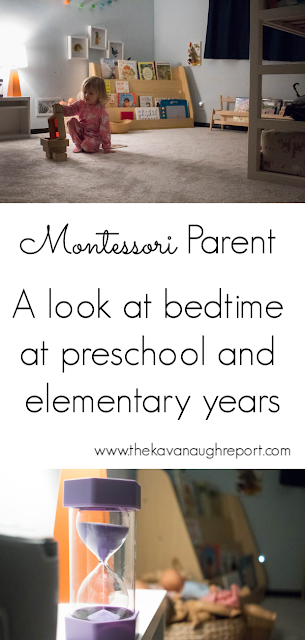A few weeks ago, I wrote about how we approach bedtime with babies and toddlers. Basically our approach can be summed up with the words "flexible routine." We follow the child and give space to allow our kids to follow their natural rhythm. And, we follow much the same routine as our children get older. We want to give them the space to follow their own sleep needs while respecting the fact that young children crave order and routine.
Preschool (3ish to 6ish)
Much like when they were toddlers, I feel like my kids have always settled into a sleep routine throughout their preschool years. This routine is supported by our own simple evening schedule. Post dinner includes baths , then pjs, then a family reading time. Unlike with a toddler, however, I don't then go lay/nurse with them. Instead, they move to a quiet time in their own space. When they are ready for sleep, they come out and let us know and we tuck them in.
This quiet play happens for Nora in her room. She has access to books, some dolls, and some simple open ended toys. We rotate the toys frequently and give her choice over what she wants to use before bed. This play can last anywhere from 10 minutes to 60ish depending on the night. Usually not more, or less than that. There is a 10 minute timer in her room which she can choose to use. We we're finding that she was coming out and asking for "a few more minutes" and this gives her a more concrete way to control that.
This post contains affiliate links at no cost to you.
The big change here from toddlerhood is the alone play. Unlike a toddler that may not be able to play alone for extended periods of time, I have found by preschool age, my kids have been able to make this transition. And, this is for everyone's benefit. I find that my kids need this wind down time to be able to relax and sleep. I also have found, that by this time in the day, I need a break too. This routine allows us to follow our child, but also have adult time where we aren't expected to be an entertainment committee.
The expectation for quiet time remains simple. Nora must play in her room. When she is done, she needs to restore her work. And, that's it.
Elementary (6+)
Elementary bedtime has a few more changes to support an increased ability to handle freedom, and responsibility. The first big change is in routine. Our routine places more choice and responsibility into our elementary child's hands. Again, being flexible and allowing for him to follow his own natural rhythm for sleep.
Before bed, Henry has the freedom to choose if he would like a shower or if he would prefer to wait until the morning. He also has the freedom to choose to join us for the picture book reading or not. Often he is interested in what I'm reading to Nora or Gus, but sometimes not. And, that's totally fine. He just needs to go play/work alone if not. Once Nora and Gus are in their room/bed, we read from a book that is more appropriate for him. Usually a chapter book, or more advanced book.
Henry also has the choice of where to have his quiet time. Sometimes he might choose to play but often he also chooses to read quietly in bed. It really depends on his mood, energy level, and preference. Henry does use a timer often when reading. It can be easy to get sucked into a good book and need a reminder about how late it is getting. We will often help scaffold this freedom by reminding him about the time, and suggesting he use his final 10 minutes.
As he gets older, we intend to allow him this freedom and give him more responsibility in making sure he is going to bed when he needs to. There are times when he tests the limits we give him - like any elementary child would! - and usually the next day he feels it. Those are the times when we can talk with him about how the choices we make can effect how we feel the next day. And, I feel those conversations have a powerful effect in helping him learn healthy sleep habits without force.
Do your older children decide when they are ready for sleep?




